This is the Tamiya 35 367 kit in 1/35 scale, of the ‘German Heavy Self-Propelled Howitzer Hummel (Late production)’. History The Hummel was developed by German designers in short time, intended to provide a quick boost for troops that had … Continue reading
Tag Archives: self propelled
Russian Tank Destroyer ISU-152 (Zvezda)
This is the Zvezda 3532 kit in 1/35 scale, of the ‘Russian Tank Destroyer ISU-152’.
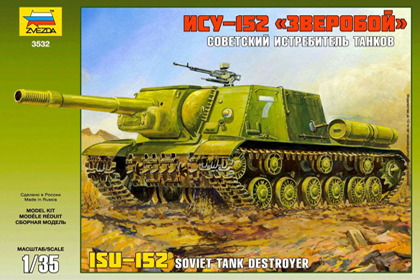
History
The ISU-152 marks its beginning on January 24, 1943. This was the moment of appearance of the first fighting vehicle of this family. It was designated Object 236 (Объект 236), using the same concept as the SU-152.
The Object 236 was completed in Factory No. 100 in Chelyabinsk, and on the same day, January 24, underwent trials on the Chebarkulski artillery range, 107 km from Chelyabinsk. By February 7, 1943 the trials were over, passed with success. On February 14 the vehicle was adopted and put on production under the KV-14 (КВ-14) designation.
In April 1943 was ordered KV-14 to be henceforth designated SU-152 (СУ-152). In time, the combat performance of SU-152, based on the KV-1S tank, made necessary the modernization of the vehicle, using the new IS tank as a base.
Manufacturer
Where I got it
- Modelskibet (September 2019)
German DAK 15cm s.IG.33 auf Pz.Kpfw.III (Dragon)
This is the Dragon 6904 kit in 1/35 scale, of the ‘German DAK 15cm s-IG.33 aud Pz.Kpfw.III’.
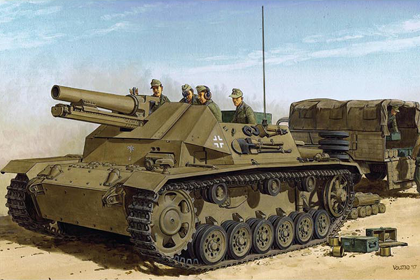
History
It represents a 15cm s.IG.33 auf Fahrgestell Pz.III which, as its name suggests, mated a 15cm field howitzer with a Panzer III chassis.
Field Marshal Erwin Rommel was seeking heavy artillery mounted on tracked chassis because horse-drawn or truck-drawn howitzers were impractical in the desert.
This SPH was used by the Deutsches Afrika Korps, specifically the 90 leichte Infanterie-Division, in North Africa. It first saw action in September 1942.
Manufacturer
Where I got it
- Stoppel Hobby (August 2019)
Russian SU-18 SPH (HobbyBoss)
This is the HobbyBoss 83875 kit in 1/35 scale, of the ‘Russian SU-18 SPH’.
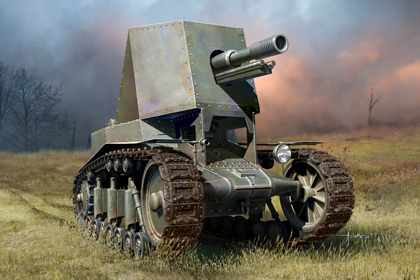
History
The SU-18 kept the same design as the French vehicle, but replaced the turret with one that resembles a truncated pyramid. The SU-18 used the 76.2mm regimental gun model 1927 with a slotted muzzle brake to reduce rollback.
The decision to build the SU-18 was made on June 11 and stipulated the delivery of a prototype by October 10, 1930. However, due to the small ammunition capability and the limitations of the T-18 (a narrow gauge chassis and a high center of gravity) the design was abandoned in favor of larger and better self-propelled gun designs and further work on the SU-18 was stopped.
Manufacturer
Where I got it
- Amazon (November 2018)
Russian Project 704 SPH (Trumpeter)
This is the Trumpeter 05575 kit in 1/35 scale, of the ‘Russian Project 704 SPH’.

History
The self-propelled gun carried 20 rounds of two piece (shell and charge) armor-piercing and high explosive ammunition. The secondary armament of the fighting vehicle consisted of two 12.7 x 108mm DShK machine guns, one anti-aircraft and one co-axial.
Manufacturer
Where I got it
- Stoppel Hobby (December 2017)
Russian SU-122, Interior Kit (Initial Production) (MiniArt)
This is the MiniArt 35175 kit in 1/35 scale, of the ‘Russian SU-122 Initial Production, Interior Kit’.
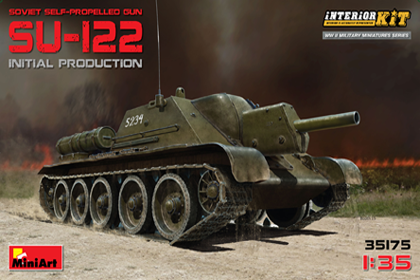
History
The vehicle was based on the T-44 medium tank chassis and was a Russian self-propelled howitzer or assault gun used during World War II.
The machine was designed to destroy fortifications, gun emplacements and tanks.
Manufacturer
German Möbelwagen 3,7cm FlaK auf Fgst Pz.Kpfw.IV (Sf) (Tamiya)
This is the Tamiya 35 237-3900 kit in 1/35 scale, of the ‘German Möbelwagen 3,7cm FlaK auf Fgst Pz.Kpfw.IV (Sf)’.
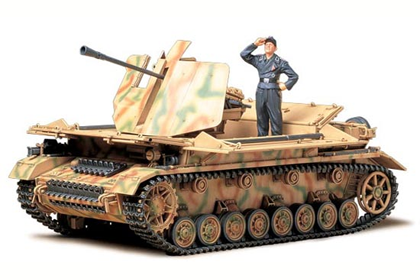
History
The mass-production model started to be manufactured in February 1944. It was equipped with a powerful 3.7 FlaK 43 cannon capable of firing 250 shots/min, and thick armored plates surrounding the upper part of the vehicle, which could be raised or lowered for horizontal firing.
By 1945, a total of 240 vehicles were produced, most of which were deployed to the western front, providing a vicious defense against approaching fighters and bombers of the Allies.
Manufacturer
Where I got it
- Stoppel Hobby (August 2015)
German Versuchsflakwagen fur 8.8cm FlaK 37 auf Sonderfahrgestell (Bronco)
This is the Bronco 35174 kit in 1/35 scale, of the ‘German Versuchsflakwagen fur 8.8cm FlaK 37 auf Sonderfahrgestell’.

History
The Versuchsflakwagen fur 8.8cm – FlaK 41 – was also known as the Grille 10 named after the Cricket insect. The Grille 10 was the first in a series of armoured self propelled guns dating from 1942.
The hull used components from several vehicles but mainly the Panzer IV and Sd.Kfz.9. The gun was mounted on the rear hull and protected by hinged side armour which folded down when in action.
Three prototypes were built in 1944, first mounting the 8.8cm FlaK 37 and later the FlaK 41. One vehicle was refitted with the FlaK 37 and sent to Italy for combat trials, serving with Flakartillerie Abt (Sf) 304 attached to the 26th Panzer Division. Trials were considered a success and a second series of Grille 10’s were ordered, but on Panther hull.
Other members of the Grille family were built on the Tiger II hull including the Grille 17 with 17cm gun, Grille 21 with 21cm mortar, Grille 30 with 30.5cm mortar and the Grille 42 with 42cm mortar.
Manufacturer
Where I got it
- Stoppel Hobby (August 2015)
German Sd.Kfz.165 Hummel/Wespe (Dragon)
This is the Dragon 6535 kit in 1/35 scale, of the ‘German Sd.Kfz.165 Hummel/Wespe’.
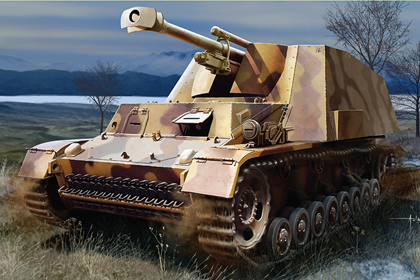
History
The Sd.Kfz.165 Hummel, of which 714 were produced from late 1942 onwards, was created because of an urgent need for artillery that could keep pace with Germany’s panzers during WWII.
Interestingly, the prototype of the Hummel was originally fitted with a 10.5cm leFH18 gun, the weapon that eventually found its way onto the Wespe that was based on the Panzer II chassis.
Manufacturer
Where I got it
- Stoppel Hobby (May 2015)
Russian Tank Destroyer ISU-122 (Zvezda)
This is the Zvezda 3534 kit in 1/35 scale, of the ‘Russian Tank Destroyer ISU-122’.
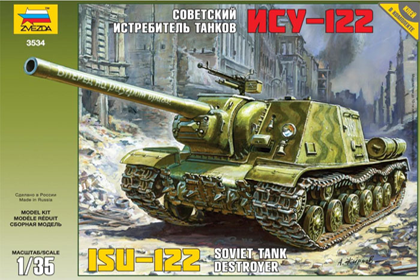
History
The ISU-122 was built on the proven chassis of the IS-2 heavy tank, which it shared with the ISU-152 self-propelled howitzer. When Soviet production of hulls exceeded their ability to produce the large ML-20S howitzers, the decision was made to install the smaller 122mm A-19S gun in the extra hulls, and the ISU-122 was born.
The new tank destroyer was equipped with a full-enclosed armored cockpit. The 122mm gun could be used to destroy both enemy tanks and fortifications. For this purpose, ISU-122s were supplied to special assault groups. Production of the ISU-122 ended as the war drew to a close. After the war, most of the surviving ISU-122s were refitted as rocket launchers.
Manufacturer
Where I got it
- Stoppel Hobby (December 2014)
German Self-Propelled Heavy Anti-Tank Gun Nashorn (Tamiya)
This is the Tamiya 35335 kit in 1/35 scale, of the ‘German Self-Propelled Heavy Anti-Tank Gun Nashorn’.
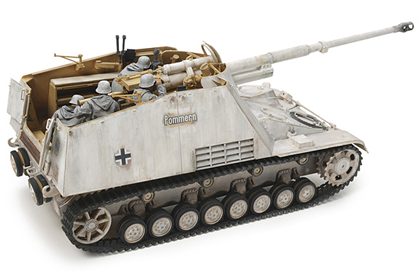
History
While deployment started in July 1943 under the moniker of Hornisse, it was given the new Nashorn designation from January of the next year, reportedly at the command of Hitler. 439 units were produced up to March 1945, and they served on both the Eastern and Western Fronts, providing heavy firepower for German forces.
Manufacturer
Where I got it
- Stoppel Hobby (December 2014)
German Ardelt-Rheinmetall 8.8cm PaK 43 Waffenträger (Dragon)
This is the Dragon 6728 kit in 1/35 scale, of the ‘German Ardelt-Rheinmetall 8.8cm PaK 43 Waffenträger’.
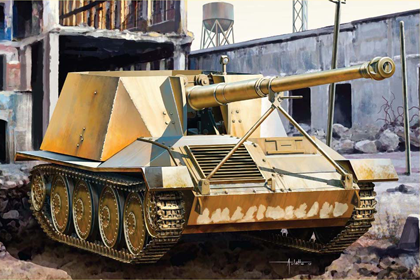
History
The vehicle’s engine was fitted at the front of the hull, which permitted the main armament – an 8.8cm L/71 cannon – to be fitted on the rear. It utilized a 38(t) chassis with four road wheels per side. An improved prototype (Ardelt II) was later produced by Ardelt and Krupp, but the end of the war intervened before production got off the ground.
Manufacturer
Where I got it
- Stoppel Hobby (December 2014)